| 1 | Himalayan pitviper |
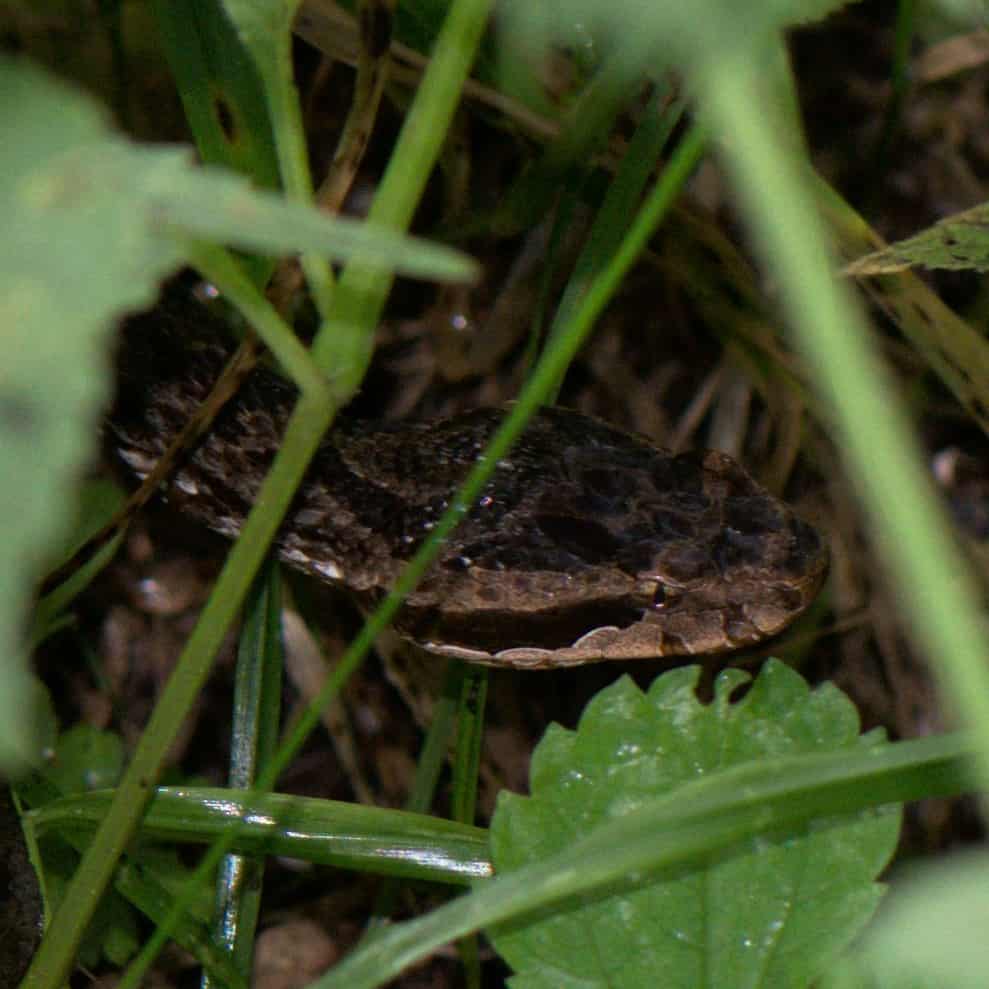
Forget swaying rope bridges, forget glacial chunks about to break off – the Himalayan pitviper is just as big a threat in its namesake mountains. This species lives in Nepal and northern India, and may reach the highest altitudes of any snake, being confirmed at 4900 metres, not far off the height of Everest base camp at 5364 metres (Nepalese side).
This species much prefers crisp mountain air to swampy lowlands. Local farmers know about this snake, but the crowds of eager hikers bustling through are another story. The Himalayan pitviper (Gloydius himalayanus) has a venom which is usually non lethal, but can unleash swelling and extreme pain near the bite mark. They won’t burst from a bush with their fangs bared (usually), but they aren’t shy and will readily lunge forward if you find one blocking your trail. As ever, the best strategy is to hold your nerve, give them a wide berth, and slowly walk by. Himalayan pitvipers live in sloping forests and rugged fields, and have a hidey hole which they return to each day.
You won’t find Himalayan pitvipers at Everest base camp, but they might terrify people on the 10 day trek in, as a piercing hiss erupts from nowhere. With the thinning air, some might believe this viper to be an altitude-induced mirage, but they’re very much a real physical being.
| 2 | Black speckled palm pitviper |
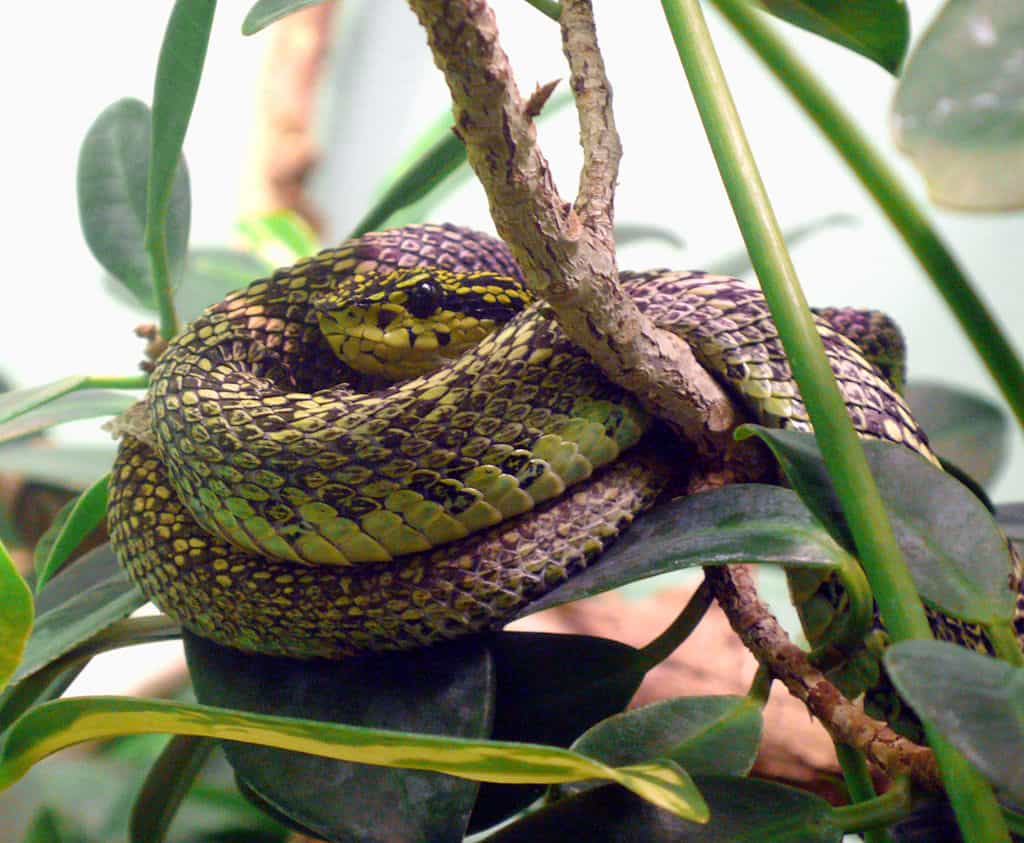
The black speckled palm pitviper resides in the green, moist mountains of Costa Rica, including the Talamanca Cordillera bordering Panama. This is a venomous snake which comfortably reaches altitudes of 3000 metres, often amidst pouring rain and swirling mist.
Black speckled palm pitvipers (Bothriechis nigroviridis) may be encountered by the edges of hiking routes by tourists, or perhaps in a tree near to where you’re eating lunch. Their bite is especially lethal, causing only minor haemorrhaging but possessing a rare toxin called nigroviriditoxin. Complicating matters is that Bothriechis nigroviridis lives in the worst places to get bitten in all of Costa Rica. You’re far from the nearest hospital, you’re on a narrow winding trail, and the chances of a helicopter landing in the mist and trees is negligible. If you do meet this snake’s fangs while hiking, then you’re in serious trouble.
More positively, Bothriechis nigroviridis is a branch snake, and is rarely in a rush to drop down just to bite a tourist it has no interest in. On many days, these mountain trails are empty, and the black speckled palm pitviper lives a quiet life. They can go for months at a time without seeing a human, far from the hustle and bustle of San José. In fact, they might even get lonely in these distant mountain hideaways. Being so mountainous, the main people to have regular contact with this snake are villages and small farming hideaways.
| 3 | Green whipsnake |
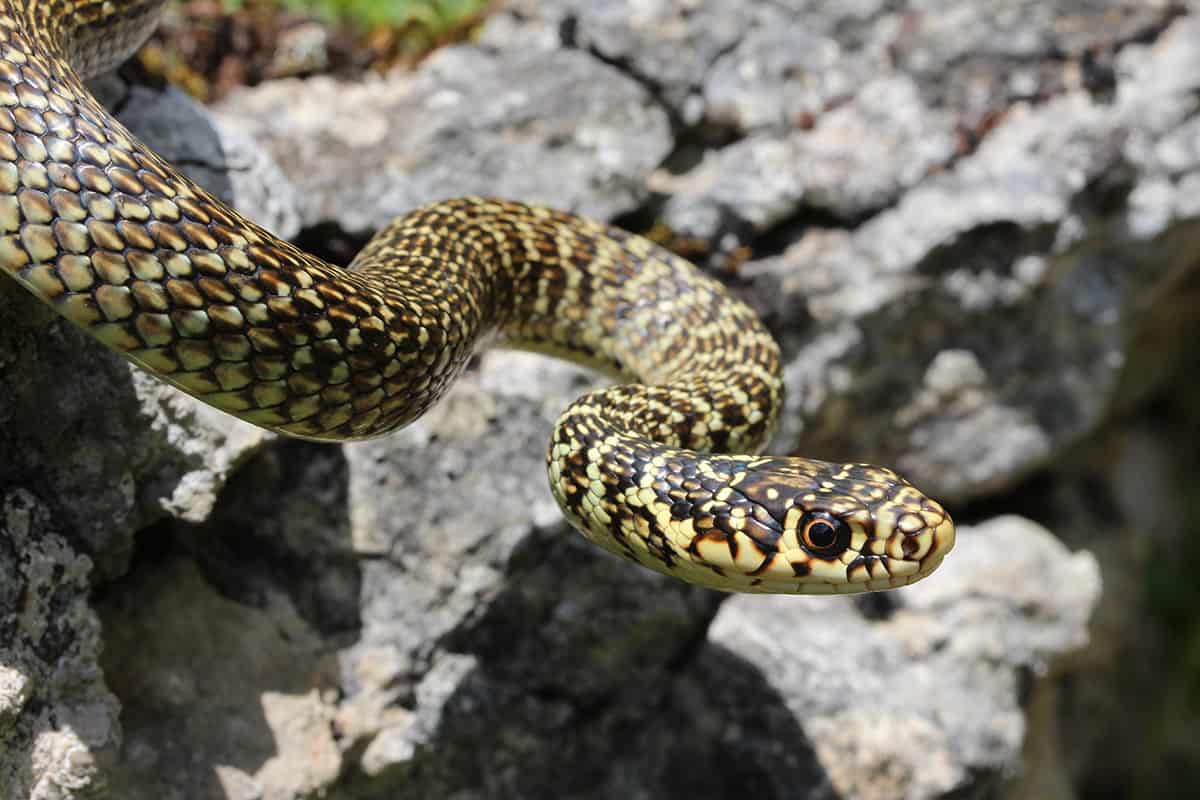
An energetic snake which can move hundreds of metres per day. Green whipsnakes mainly inhabit Italy and southern France. Though they also inhabit lowlands, green whipsnakes love rugged open areas, meaning that mountain colonies make perfect sense. This species is particularly abundant in the Pyrenees mountains straddling France and Spain, with Andorra lodged in the middle. Green whipsnakes are regularly seen racing along winding mountain roads, sometimes being run over, other times just managing to duck out of the way.
They’re particularly obsessed with the natural thermal spas dotted around the Pyrenees, many being abandoned tourist sites. The Pyrenees is volcanically active, and these pockets of warmth are irresistible for a green whipsnake which has strayed so high. The roads near these mountain spas are one of the top places to observe green whipsnakes on Earth (sometimes dead unfortunately).
The Pyrenees are the last stop of this species. Green whipsnakes are only found in the extreme north of Spain, and as the mountains fall away and Spain begins properly, they completely disappear. This snake has a wildly varying diet, with two favourites being common wall lizards and wood mice. They’re non-venomous, but can turn savagely bitey if pushed.
| 4 | Taiwan pitviper |
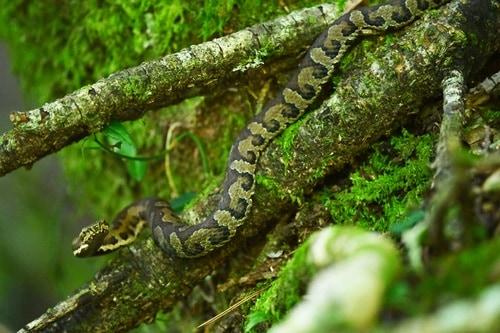
This 60cm snake is a quiet citizen of Taiwanese mountains, reaching towering heights of 3500 metres, and rarely appearing below 2000 metres. You probably won’t find Taiwan pitvipers on the windswept summit of a mountain, waiting to greet people just staggering to the top. They’re more common in grassy, rocky fields slightly lower down, where they love to bask in the sun in open spaces. Panting hikers will walk right past this snake, lumbering under the weight of a huge backpack, and never realise that they’re there, distracted with their own troubles.
Though venomous, Trimeresurus gracilis specialises in local skin chaos and not dealing out death, although there’s still the problems of being on an isolated mountainside. If they’re on the path, you’ll probably grind to a halt, while if they’re in the long grass, you’ll walk past obliviously and escape by default, even if they coil up into their usual lunging posture. Still, keep your wits about you in the mountains of Taiwan (if you’re ever there).
This species relies strongly on lizards as a juvenile, but transitions to a diet of 68.1% mammals as adults (study). Males were more reliant on shrews, while females favoured rodents. They’re part of the Trimeresurus pitviper family, most of which aren’t high altitude lovers at all – the large-eyed pitviper is a staple of marshy Bangkok.
| 5 | Meadow viper |
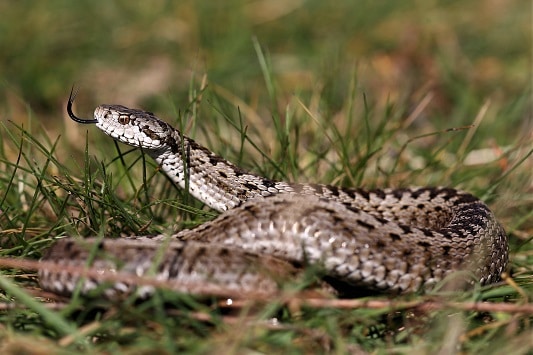
This European snake is such a mountain lover that it’s sending them down the path to extinction. Meadow vipers have extremely narrow habitat requirements. They loathe forests and are never found in them. Instead, they like rugged open areas at high altitude, often with melting spring snow patches, the kind of place frequented by hikers with poles in each hand. They’re particularly common near thorny juniper bushes, and rocks which they can bask on for warmth.
Meadow vipers can appear in ancient mountain passes at altitudes of 3000 metres. They also appear in valleys lower down, but only in lush open meadows with an abundance of wildflowers. Meadow vipers are extinct in Austria (unless a few survivors are hidden), but still have fragmented colonies in the Swiss and Italian alps.
Though unlikely, there’s a chance of you bumping into one on your summer hiking holiday. Watch out for a piercing hiss and rapidly tightening coils – this is a sign of a meadow viper preparing for attack. Meadow vipers are quite nervous for a snake and get agitated very easily. They foolishly draw attention to themselves, which is why so many have been killed by scared alpine farmers.
| 6 | Wilson’s montane pitviper |
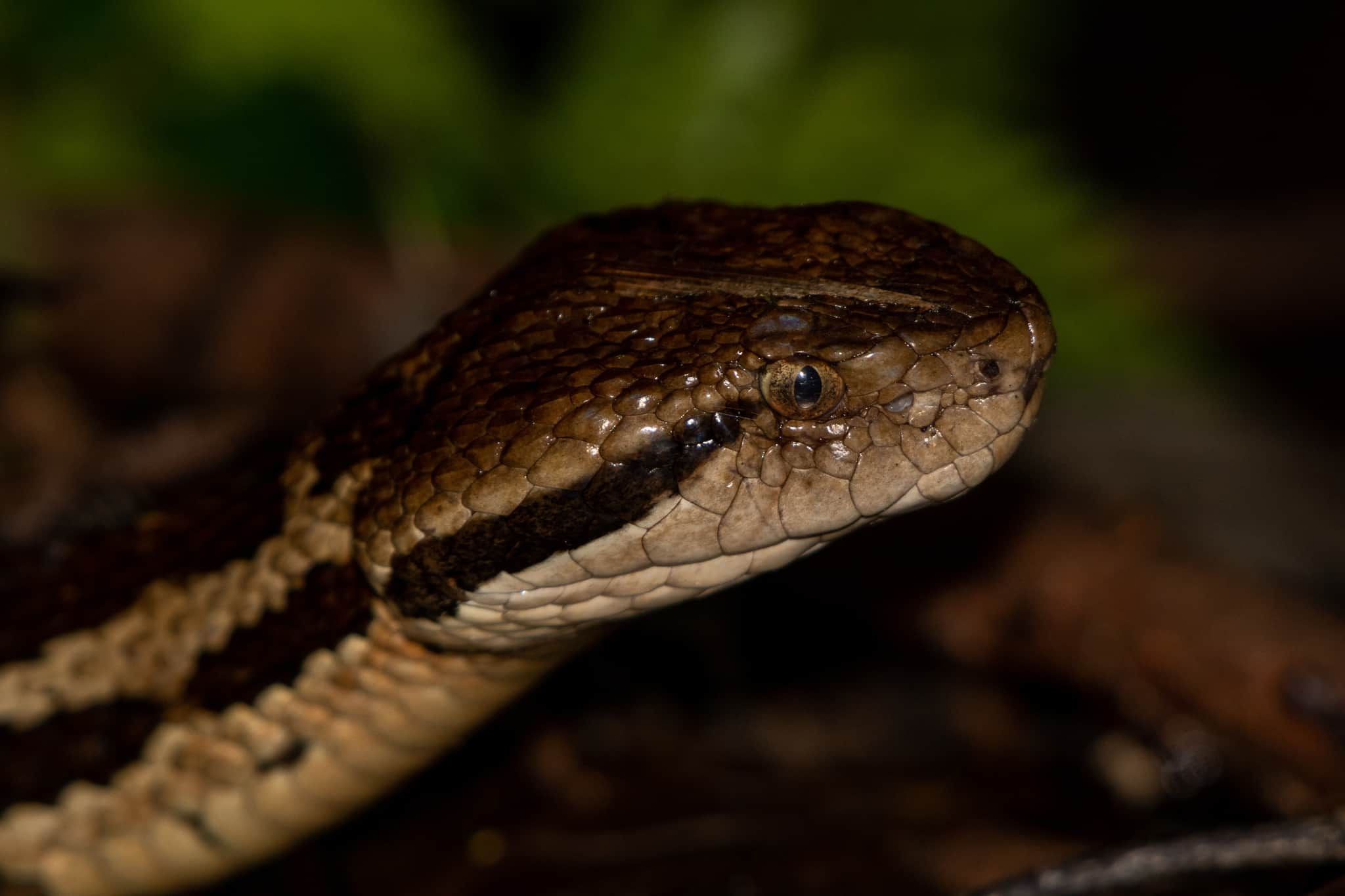
A resident of Honduras and El Salvador. Wilson’s montane pitviper lives a remote mountain life far from prying eyes, at altitudes of 1400-3491 metres. Though rare near humanity, they can reach high densities in their forested mountain slopes.
This species probably inspires a great deal of fear in local villages, looming over them with its presence. Every time they look up and see the distant peaks, they’re reminded of the venomous pitvipers lurking on its slopes. They tend to not live in villages themselves, but untouched areas several miles away, greatly increasing the local rumours and superstition. Wilson’s montane pitvipers prefer forested mountainous areas, but also appear in deforested areas directly adjacent.
Despite the villagers’ fears, Wilson’s montane pitvipers are usually performing far more innocuous activities: searching for the correct ambush position, following scent trails, or hissing if a bird gets too close. Cerrophidion wilsoni aren’t actually guarding the mountain’s slopes against all who dare to enter them.
This species gets most of its calories from mammals, but also includes giant whiptail lizards (Aspidoscelis motaguae). Cerrophidion wilsoni moves small distances per day. They prefer to rest on the ground, climbing low branches only occasionally, if the scent of prey tempts them to be more daring. This species also has a white mouth lining like a cottonmouth’s. Of course, most people never see this, except lost mountain explorers.
| 7 | Berg adder |
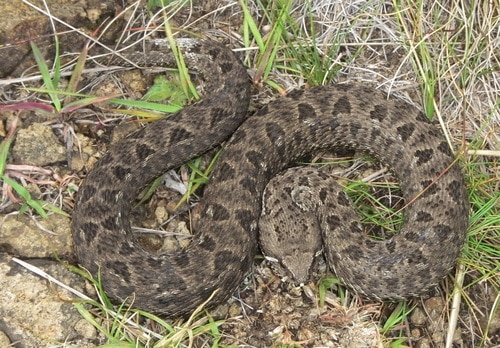
One of South Africa’s highest climbing species. The berg adder is a dangerously venomous serpent which lurks in ambush for lizards, disguised by swaying thickets. This species knows it can’t compete with the puff adders and cape cobras prowling the lower savannahs, so instead they established themselves secure mountain colonies.
You can find berg adders slithering around rugged mountainous grassland with a healthy amount of rocks, maybe near the remnants of an old campfire. Berg adders reach altitudes of 3000 metres in Zimbabwe, where they rarely appear below 1500 metres. The berg adder is such a mountain lover that it is now split into pockets across southern Africa, clinging to peaks and not wanting to leave.
Berg adders are related to the puff adder, but only measure 30-40cm as opposed to 1 metre. Size shouldn’t be mistaken for timidity, as the venom is strongly neurotoxic and can lead to lung failure. Fortunately, they’re not aggressive and won’t hunt humans down. Don’t worry too much about lighting a campfire; this species won’t suddenly swivel around and head determinedly towards the flickering flames. They have no burning desire to bite humans at all (but could do).
| 8 | Lined snake |
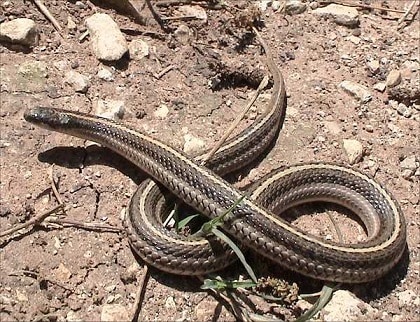
A species of the US mid-west, east of the Rocky Mountains. This is a nocturnal snake which eats earthworms, and loves to ride under cover with several of its kind. The stealthy lined snake is never found in lush forests with flowing streams, instead preferring dry rock plains and hillsides.
Though normally found at low altitude, they reach dizzying new heights in the western foothills of the Rockies, where their territory ends. The highest they’ve been spotted is at 2810 metres on Capilla Peak, New Mexico. This observation in 2009 smashed through the previous record of 2035 metres, also in New Mexico. Lined snakes rarely take advantage of the spectacular views available to them. They’re way too preoccupied with the tunnels and burrows of their wispy grass fields. Lined snakes are beige themselves, so they’re extremely difficult to spot amidst constantly swaying prairie grass. Finding a lined snake is a real prize even for a dedicated herpetologist.
Being so rarely seen, there’s probably colonies on mountaintops which are yet to be discovered. You could summit the trail with a backbreaking sweat, yet still be rewarded with no sign of anything. There’s a good chance that the lined snake altitude record will be broken again in a few years.
| 9 | Querétaro dusky rattlesnake |
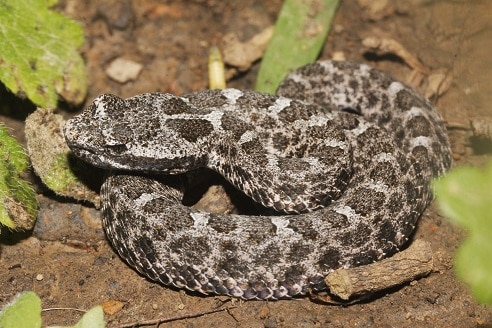
One of the highest altitude rattlesnake members. This is a non-venomous ambush snake which feeds on voles and fellow snakes, and is rumoured to reach 4400 metres, inhabiting the rugged central Mexican plateau. The Querétaro dusky rattlesnake (Crotalus aquilus) lives in its own world, barely aware even of the existence of humanity. Crotalus aquilus is concerned with the mice numbers on its local grassy slope, whether the sun will appear for a bit of warmth, and hiding from that eagle-shaped dot in the clear skies above.
Querétaro dusky rattlesnake reach altitudes that far outstrip its fellow rattlesnakes, such as the tiger rattlesnake, which stays at 0-700 metres. At some point, Crotalus aquilus realised that it could reach higher levels than its cousins, with the thin air and milder temperatures being relaxing rather than punishing. With less competition, they ditched the humid lowlands and adapted ever further to the rugged mountains.
Querétaro dusky rattlesnakes sometimes enjoy the sun, but just as often a thick mountain mist, which could disorient tourists and send them stumbling into them. Querétaro dusky rattlesnake are fairly common in their mountain forests – finding one isn’t exceptionally lucky. If you’re lucky, you can even spot two males duelling each other amidst rocks and logs. One hotspot for this snake is El Chico National Park, where they’re supposedly unusually aggressive.
| 10 | Terrestrial garter snake |
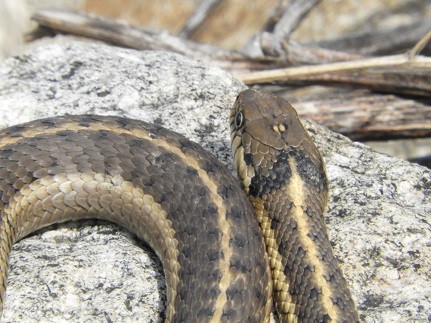
The terrestrial garter snake is the second most widespread species of garter snake. Their hardy, tough nature is why, coping well with numerous habitats, and this includes mountain slopes at up to 3993 metres. Though terrestrial garter snakes have no burning desire to live in mountains, if prey scents carried on the wind call out to them, then that is where they’ll go.
This is one of the least water-loving garter snakes, which aids them in rugged uplands. Their diet is more suitable for mountainous realms, as they lean heavily towards mammals, versus the frog obsessions of most garter snakes. Other records of altitude include 3555 metres and 3962 metres.
Thamnophis elegans has some truly spectacular views in the mountain slopes they slither up to, but whether they actually enjoy them is something only they know. Bears have been witnessed admiring Siberian sunsets, but garter snakes are that bit more primitive. Perhaps they’re too distracted with hunting, or perhaps they climb onto a rock occasionally to admire a distant peak.

Dear Sir/Madam,
I am writing a children’s book on snakes.
I seek permission to use the ten photographs on your website in my book.
I intend to acknowledge the source.
Greetings Kai. None of the photos on this website are mine currently; they are used under creative commons licenses. Others are in the public domain. You can find links to the owners of the images below each image in the small text. You need to speak to these owners, not me. Perhaps you should stick to images in the public domain (CC0) as these have no restrictions.